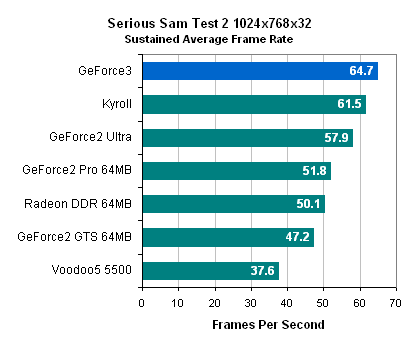From the results we're seeing, it looks like same-generation cards are matching up similarly to how they do in real games: the GF4 4200 seems to be just ahead of the Radeon 8500, and the GFfx Ultra is a little bit ahead of the 9700 Pro. So why all the whining from Nvidia?
Here's how things seem to stack up:
GF4MX 440 - ~250
Radeon 9000 - ~1000
Radeon 8500 - ~1100
GF4 Ti 4200 - ~1300
GF4 Ti 4600 - ~1600
Radeon 9500 - ~2800
Radeon 9500 Pro - ~3500
Radeon 9700 - ~4000
Radeon 9700 Pro ~4800
GFfx Ultra - ~5100
Obviously, Nvidia's problem is that while their same generation cards all win, ATI has a higher generation part at every price point (until GFfx comes out). Let's see if we can trace Nvidia's complaints back to the actual reasons their GPUs are uncompetitive in 3dMark03...
The 128MB GF4MX 440 sells for about the same as a 9000; the only GF4MX 440 scores I can find in the ORB are 64MB, but it shouldn't affect anything since they can only run game1. How much is the 9000 getting from it's ability to run game2 and game 3? Well, according to
this guy's report, about 535 marks. The 9000 is still about twice as fast as the GF4MX 440 in game1 alone.
The reason for this would appear to be...the fact that the 9000 is 4x1, the GF4MX is 2x2, and game1 is mostly single-textured, which is exactly what Nvidia complained about! Direct hit!
Now, the GF4 Ti4600 amazingly sells for
more than the 9500 and 9500 Pro. Let's compare some subscores:
The
GF4 Ti4600 gets around 750 marks from game1, 415 from game2, and 490 from game3.
The
9500 NP gets around 790 from game1, 600 from game2, 740 from game3, and 700 from game4.
The
9500 Pro gets around 925 from game1, 780 from game2, 960 from game3, and 890 from game4.
If we take game4 out of our scores, we have the 9500 NP around 2100 and the 9500 Pro around 2600. The 9500 NP gets the remaining 500 marks over the 4600 primarily via roughly 50% better performance on games2 and 3. Nvidia's complaint about these games is that they both use PS1.4 with PS1.1 fallbacks; if the R300 can run PS1.4 shaders at roughly the throughput NV25 can do PS1.1 shaders, then it's very reasonable to guess that the extra passes are the only thing seperating the 4600 and 9000 NP in this bench. Another on target complaint from Nvidia. (OTOH, are the shaders really common enough that the 9500 NP's smaller multitexturing rate never comes into play?) Meanwhile, it's interesting to note that the 9500 NP also fails to take a penalty in game1 to the extent it is single-textured.
Meanwhile, the 9500 Pro's remaining 1000 marks over the 4600 come in the form of 175 marks on game1 (higher pixel fillrate, again with the single-texturing), and 350 on game2 and 475 on game3. 9500 Pro's margin over 4600 is nearly double that of 9500 NP in these tests; obviously this is pure pixel shading power coming to bear.
Finally, let's look at a
9700 NP score for kicks. Compared to 9500 Pro, we see gains of 16% in game1, 23% in game2, 16% in game3, and only 1% in game4. (These might be lower than actual due to the stronger CPU score on the 9500 Pro.) Clearly game4 is completely shader-limited (no surprise there), while the other three games benefit moderately from the extra bandwidth; game1 perhaps only because it raises single-texture fillrate, whereas games 2 and 3 are still very moderately bandwidth bound.
Compared to today's games, then, it appears 3dMark03 is very much shader-limited, and much less bandwidth-bound than the average. One reading of this conclusion is that it would benefit the GFfx, although as we've seen its higher clocks don't seem to translate to higher shader performance; still, it's worth noting that the 9700's extra bandwidth may be buying it less vs. the GFfx than on many games. OTOH a case can be made that this is a proper weighting on Futuremark's part: the argument being that a 2004 budget/mainstream card (what this suite should be aimed at, IMO) will probably have a considerably higher shader throughput-to-bandwidth ratio than, say, the 9700.
As for Nvidia's arguments, they're still pretty silly. Nonetheless it's nice to see they at least address what are likely the primary causes of the Nvidia lineup's disastrous showing compared to the ATI product in each card's price bracket. Before I started this post I thought the complaints were not only childish but didn't even speak to Nvidia's weaknesses.
Congrats Nvidia: this temper tantrum would appear to be the best-targeted piece of engineering you've released in the past 12 months!

So them's my conclusions. Perhaps someone will bother searching the ORB for better examples than I picked (I didn't bother matching CPUmark scores, for example, although I was careful to at least stick to stock GPU clocks).
One final note: it's interesting to see that the 9000 loses just as many marks compared to the GF4 4600 on the game2 and 3 tests as on game1, despite its ability to use the PS1.4 path. Is the pixel shader throughput on R200/RV250 that much worse than NV25? (It sort of looks like the presumably FP32-related pixel shading penalty on NV30!) Or is there something else slowing them down in those tests?

